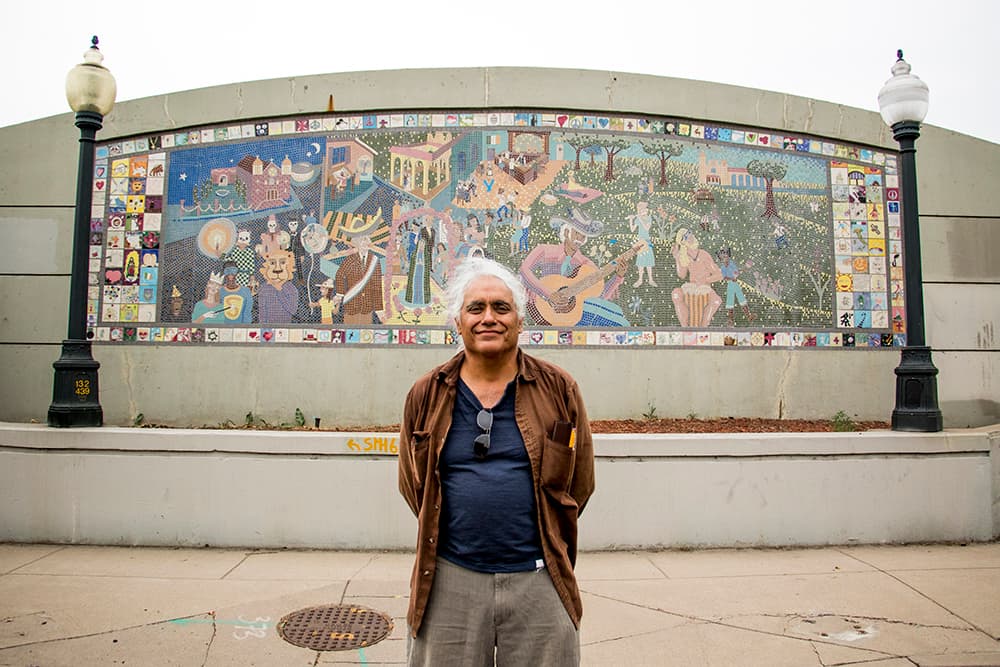
This weekend Westwood will celebrate its 7th annual Chile Fest, a street fair that takes over Morrison Road to celebrate the "Hispanic-centric cultures" that make up 80 percent of the neighborhood's population. This year, audiences will celebrate under a slew of new murals painted along the strip, a sign of Westwood's growth as a newly-dubbed cultural district.
As we enter Hispanic Heritage Month, we thought we'd take a look at the public art in Westwood and around Denver produced by Hispanic, Latino and Chicano artists and ask what it means to be represented in the city's artistic life.

Josiah López grew up in Westwood. He's been making art with spray cans since he was a teenager. Before he earned his Master of Fine Arts from CU Boulder, he was a graffiti artist, "one of the kids they wanted to paint out,” he said.
Westwood, said López, has not always had a great reputation. He remembers when Morrison Road was rife with tags and gang signs. Today, he said, he's glad to be a part of the neighborhood's revitalization.
"It’s good to give back," he said. "People want to see something nice."
These days López is regularly commissioned by the city's Urban Arts Fund, an initiative to fill graffiti-prone spots with vibrant art. This is the third time he's graced this wall on the side of Ernie's Automotive with his work.

Artistic growth in a city's underserved communities is not always a welcome thing. "Artwashing" is a term that's come to describe early stages of gentrification, generally when hipsters move into low-rent studios to pursue their crafts. But the new creative life growing on Morrison Road is not emblematic of this kind of change. Instead, artists like López have been selected to work in the corridor expressly because they have roots in the neighborhood.
Tariana Navas-Nieves is Director of Cultural Affairs for Denver Arts & Venues. As the "guardians of the public arts program within the city," she told Denverite, "it's key that we not just take every project and look at it in a vacuum, but also look at it in context to the community."
Santiago Jaramillo is another Westwood local who's been commissioned to paint Morrison Road. His work covers many of the concrete planter boxes speckling the sidewalk, as well as the Mercadito, a fresh food venue run by the nonprofit Re:Vision. Jaramillo also thinks it's important to contribute to his neighborhood's vibrancy.
"It gives you some pride, history and background," he said.

As with Westwood, the city has tried to select public artists in other historically Latino neighborhoods to reflect the local cultural history. It would be folly to say that every artwork produced by a Latino artist represents the same identity, and these murals depict the range of identities present in Denver.
Along the walls of the La Alma recreation center in Lincoln Park, you'll find a massive piece with parallel figures: an indigenous warrior on the right and, on the left, a modern man, his t-shirt adorned with the three-faced Mestizo symbol (which represents the combination of European and Mesoamerican roots to produce a third, mixed identity). This piece was painted by Emanuel Martinez, a Chicano artist who created many of the movement's symbols.

In Highland, along the wall separating homes from I-25, you'll find ten mosaic panels depicting the history of the neighborhood. Prehistoric dinosaurs lead to pre-colonial indigenous people, then to Hell's Angels and a vibrant and diverse community. "Neighborhood Epic," created by Bob Luna and Martha Keating, reflects the Northside's multicultural history.
While Chicano symbols are important to representing part of Denver's cultural heritage, he said, there's much more to the city. Even the idea of lumping all Spanish-speaking peoples into one category misses deeper complexities.
"We wanted to relate to the story of this neighborhood," Luna said, and that picture is one of a spectrum of identities. Everyone has a "personal relationship and personal view" with their own backgrounds, be that Chicano or Spanish or Hispanic or Latino -- or Italian for that matter.

It's fitting, then, that Luna and Keating's work is a mosaic, a whole made of many pieces. Each panel is even bordered by tiles created by locals themselves, a true representation of the very many people that made up the Northside community during the period when it was produced.

If you're thinking about Hispanic Heritage Month this weekend, you might peruse the Chile Fest on Morrison Road this weekend and take a second glance at the artwork that surrounds you.
The symbols and styles you'll encounter have been produced, as Tariana Navas-Nieves said, “by the community, for the community.”
If you'd like to see more, we rounded up a bunch of public art. Some of these are sanctioned by the city (some of their "favorite Hispanic artists") and some are pieces we've come across along the way. Do you have a favorite Hispanic Heritage Month mural that we missed? Tweet it to us @Denverite!
Correction: Tariana Navas-Nieves' last name was corrected from "Tariana Navas"











